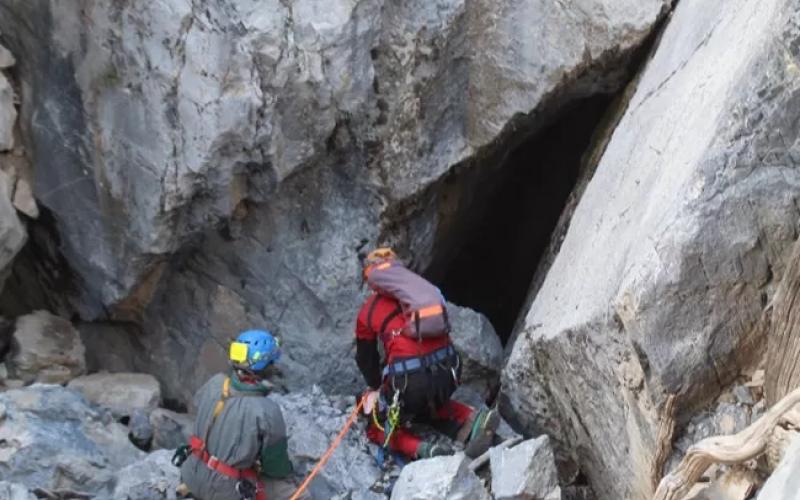The Midden: Geologic Fundamentals of Great Basin National Park Caves

This article is the last in a series of posts showcasing articles published in the Summer 2023 issue of “The Midden”, Great Basin National Park’s semiannual resource management newsletter. The series will introduce you to some of the issues, projects, and management strategies currently happening in Great Basin National Park.
Caves only form in specific rock layers. This article highlights those rock layers for Great Basin National Park, as well as three different ways that caves form in the Park.
Geologic Fundamentals of Great Basin National Park Caves
By Louise Hose, Cave Specialist-Geologist for Great Basin Institute
All known caves in Great Basin National Park formed in rocks made up of the minerals calcite (CaCO3) or dolomite [MgCa(CO3)2]…or both. But, they developed in five different rock units by three different mechanisms in two different geologic settings. This article will provide a brief overview of these various factors within the Park.
ROCK TYPES
All known caves are within limestone (rocks comprised of calcite) or dolomite (rocks comprised of the mineral dolomite) but several units of different ages and varying amounts of magnesium (Mg) host the caves.
MIDDLE CAMBRIAN POLE CANYON LIMESTONE
The Middle Cambrian Pole Canyon Limestone is the oldest and most prolific cave-bearing bedrock unit in the Snake Range. It deposited in a shallow sea along the western edge of the proto-North American continent approximately 515 Ma. It is mostly made up of calcite with only a little magnesium.
POLE CANYON MARBLE
Caves within the Baker Creek and Lehman drainages developed in a marble that formed when the Pole Canyon Limestone experienced intense shearing stress and, probably, heat from a gigantic fault about 17 million years ago. This metamorphism obscured all original characteristics of the rock except its chemistry, which remains mostly calcite with some bands of dolomite.
UPPER CAMBRIAN NOTCH PEAK
Two caves in the Snake Creek drainage and two high-elevation caves formed in the Notch Peak Limestone which is generally characterized as a very fine- to fine-grained limestone with chert nodules and stringers. Just a little younger than the Pole Canyon (maybe 500 to 485 million years old), it was probably also deposited in a shallow sea along the western edge of the developing North American continent.
ORDOVICIAN-SILURIAN FISH HAVEN AND LAKETOWN DOLOMITE
One small cave and spring in the Snake Creek drainage formed in the Ordovician and Silurian Fish Haven and Laketown Dolomites. This rock unit is a series of resistant, ledge- and cliff-forming dolomites with abundant fossils including branching corals. The unit was deposited in a lagoon or shallow shoal setting approximately 440 million years ago.
DEVONIAN SEVY DOLOMITE
One small cave in the South Fork of Big Wash lies at a triple junction of three different rock units and may lie in one of two: the Sevy Dolomite or the Devonian Guilmette Formation. The Sevy is a thin- to medium-bedded, very fine-grained, non-fossiliferous, laminated dolomite with a lack of fossils. It was deposited on extensive mud flats as a restricted lagoonal shelf or sabkha facies about 400 million years ago.
MIDDLE AND UPPER DEVONIAN GUILMETTE
The Devonian Guilmette Formation hosts at least one significant cave just outside the Park and a previous researcher placed the South Fork of Big Wash cave within it. It is a slope- to cliff-forming, dark gray, thin-bedded to massive, very fine-grained limestone with some brown to dark brown dolomite. Fossils include corals, gastropods, brachiopods, crinoids, and stomatoporoids deposited on a subtidal, intertidal, and supratidal shelf in a shallow sea.
MECHANISMS OF CAVE DEVELOPMENT
Caves within the Park formed in three general ways: 1. Hypogenesis; 2. Epigenesis; and 3. Tectonic movement. Many of the caves, perhaps most, experienced elements of more than one of these processes.
HYPOGENESIS
Most caves in limestone and dolomite form as the result of dissolution. Acidic groundwater dissolved the calcite or dolomite minerals in the rock and form voids. Hypogenic caves form from groundwater rising from depth carrying carbon dioxide (CO2) and/or hydrogen sulfide (H2S), which form carbonic acid (like soda pop) and/or sulfuric acid (like battery acid) to the top of the water table. These acids hollow out the limestone, marble, and dolomite. Lehman Caverns is the most prominent example of a hypogenic cave in the Park. It probably formed from both sulfuric and carbonic acid rising from deep below.
EPIGENESIS
The traditional, textbook explanation of how caves form says that rainwater and snowmelt pick up carbon dioxide in the atmosphere and soil to form carbonic acid, which dissolves the limestone, marble, and dolomite. The Baker Creek System of caves has formed and continues to form mostly through this process.
TECTONIC MOVEMENT
When fissures open in the bedrock, sometimes large fissures behind a massive, shifted rock forms a cave. Some high-elevation caves in the park are deep, narrow cracks formed by such action.
THE SNAKE RANGE DÉCOLLEMENT
Around 17 million years ago, a massive, low-angle fault removed about 5000 vertical meters of rock from the area of the Park and shifted much of the rock to the current Confusion Range to the east. Rocks above the Snake Range Décollement (SRD) are extremely fractured, contorted, and show up in the upper elevations of the Park. At least a half-dozen caves have formed in the upper plate above the décollement. Immediately below the SRD, the marble formed from the shear stress. Lehman and other caves in the Lehman and Baker Creek drainages developed in this marble. Many, smaller caves formed in the less disturbed rocks below the décollement.
Photo: Cave scientists prepare to rappel into one of the high-elevation, tectonic caves within the Park. Great Basin Institute/Peter Druschke
